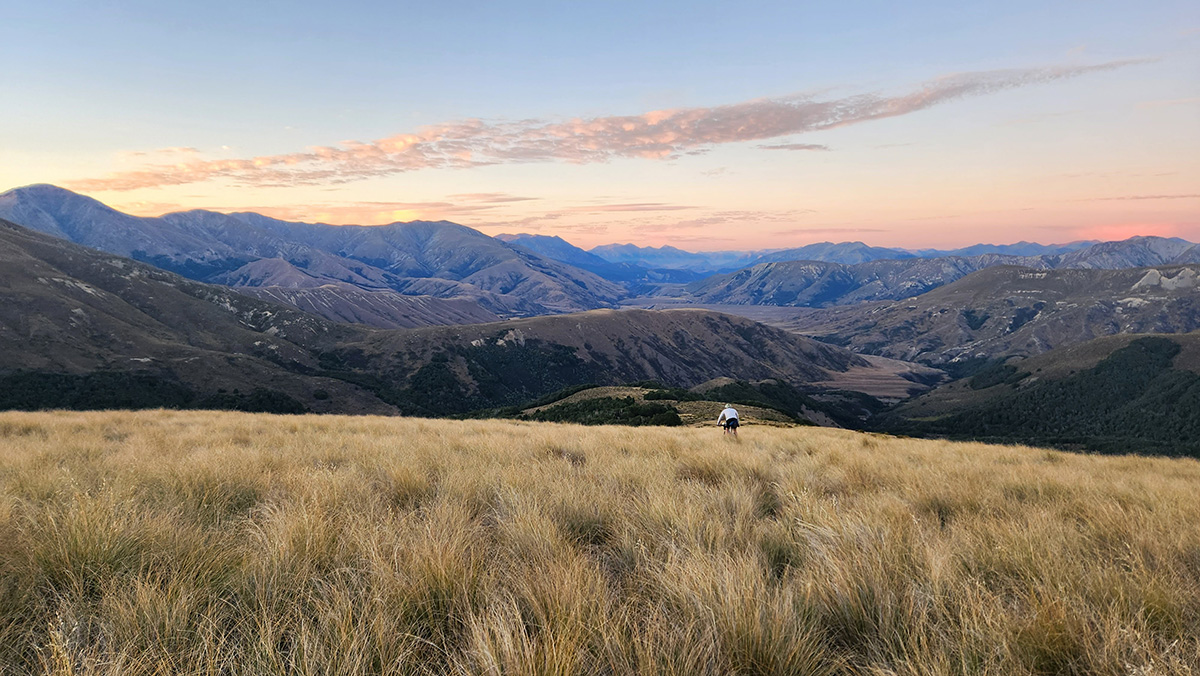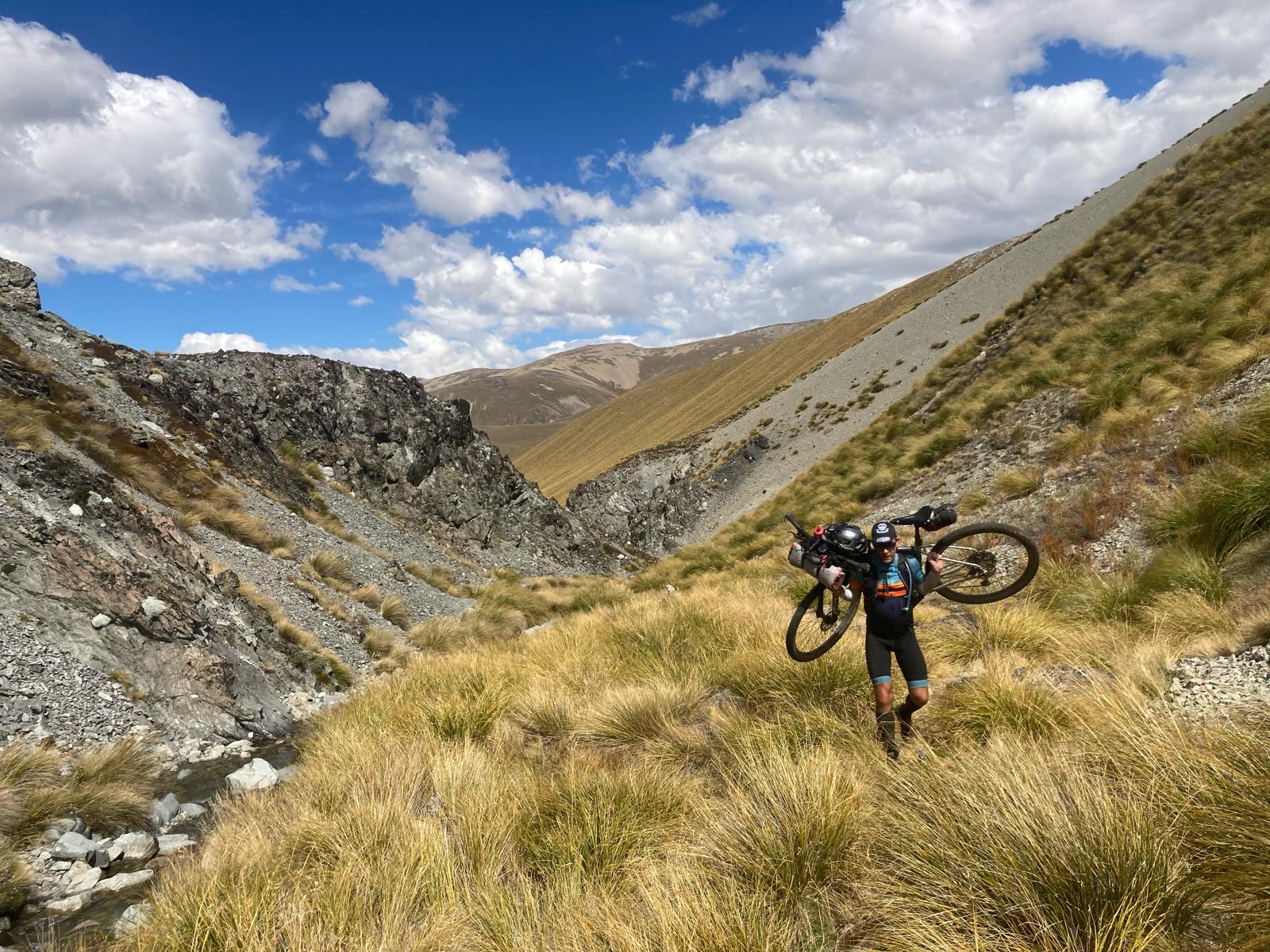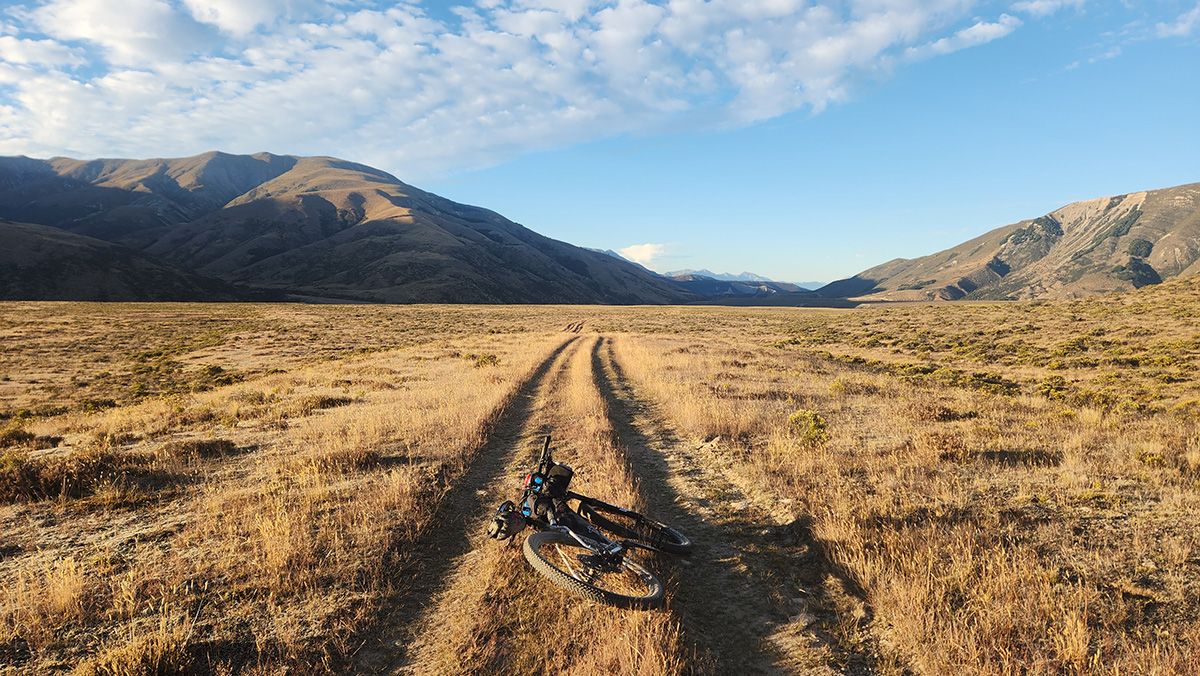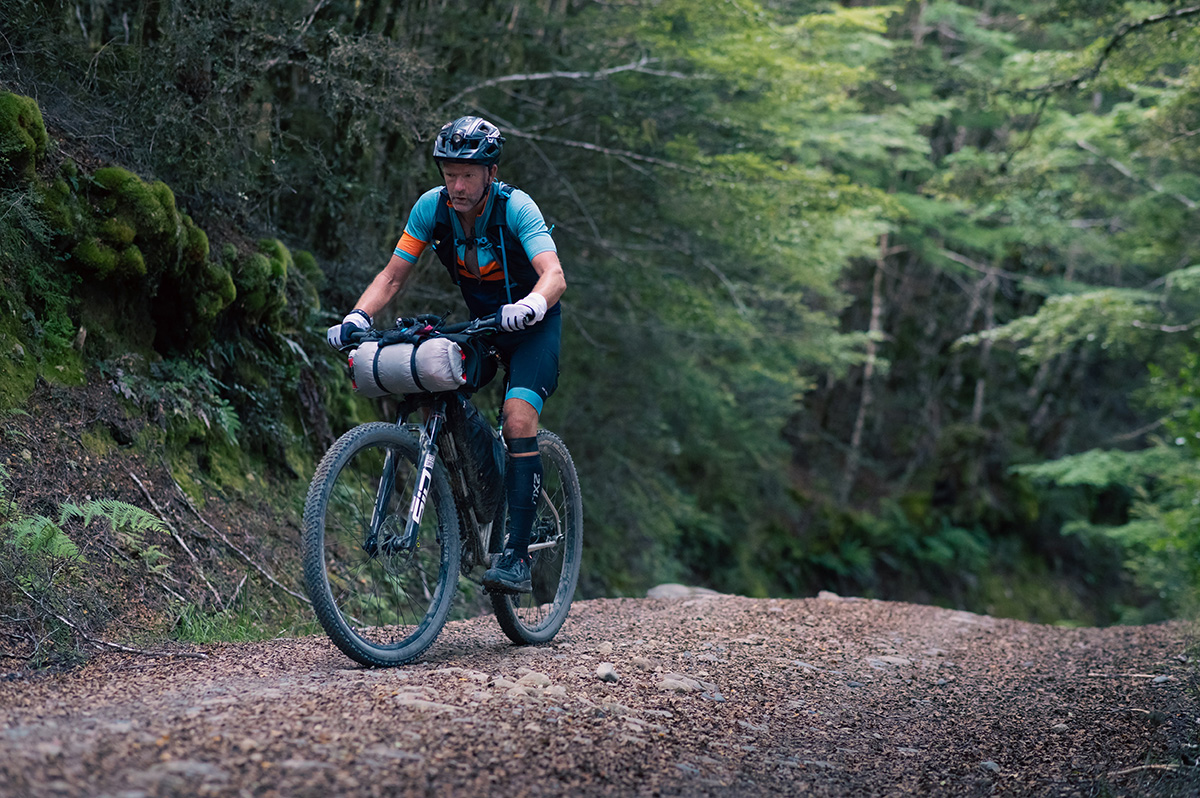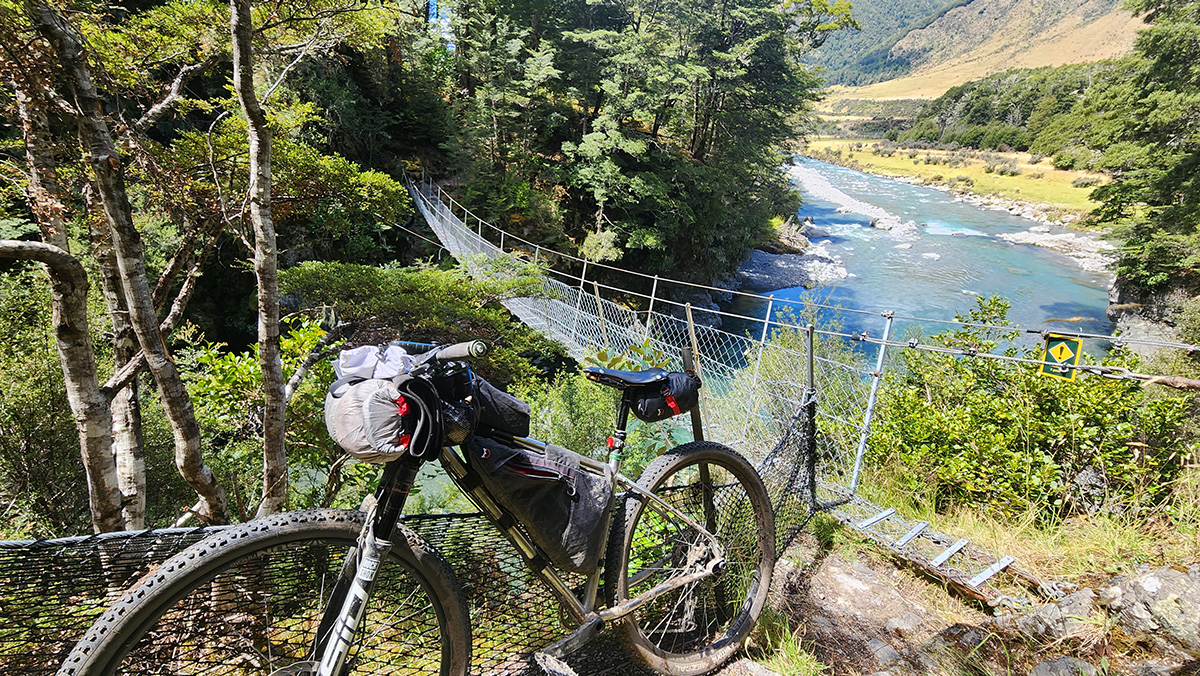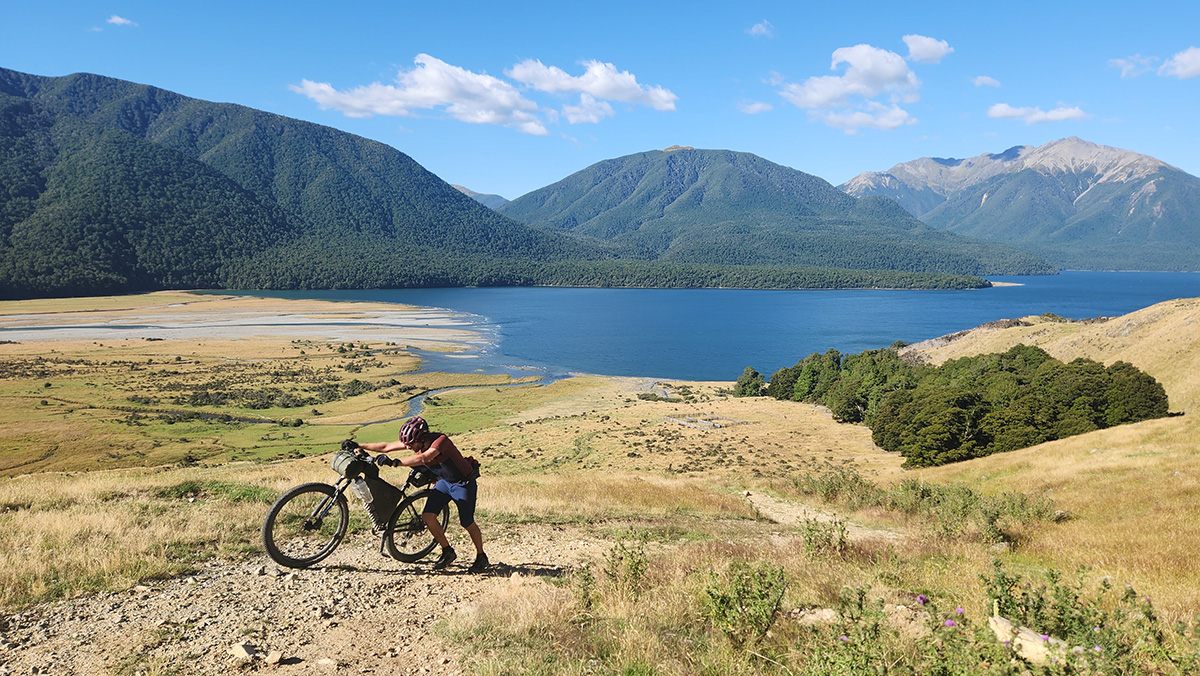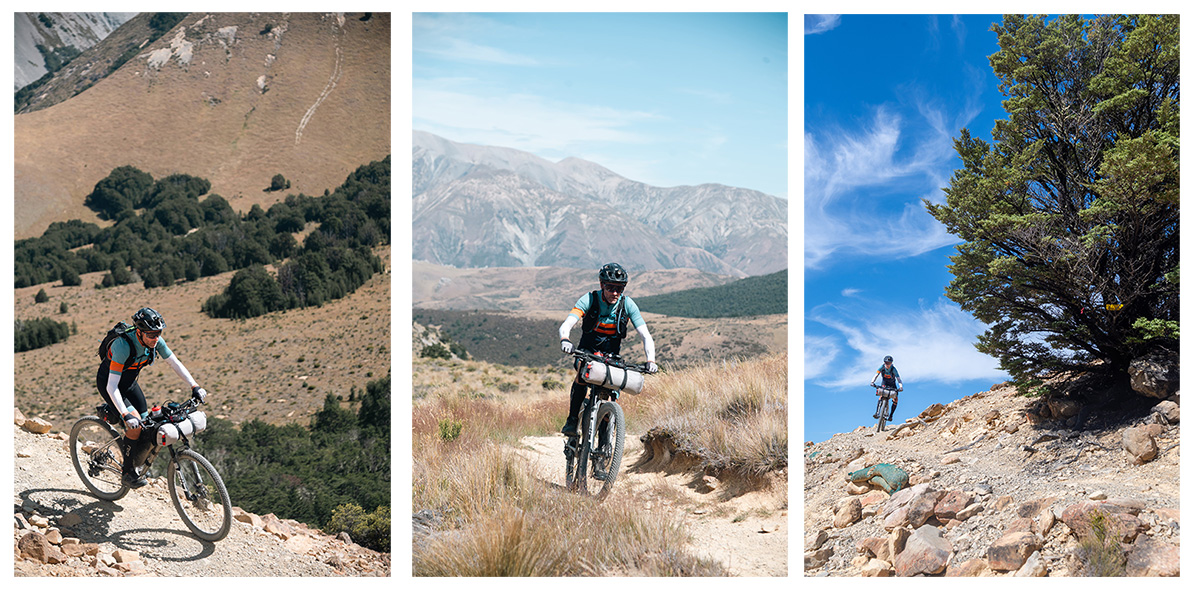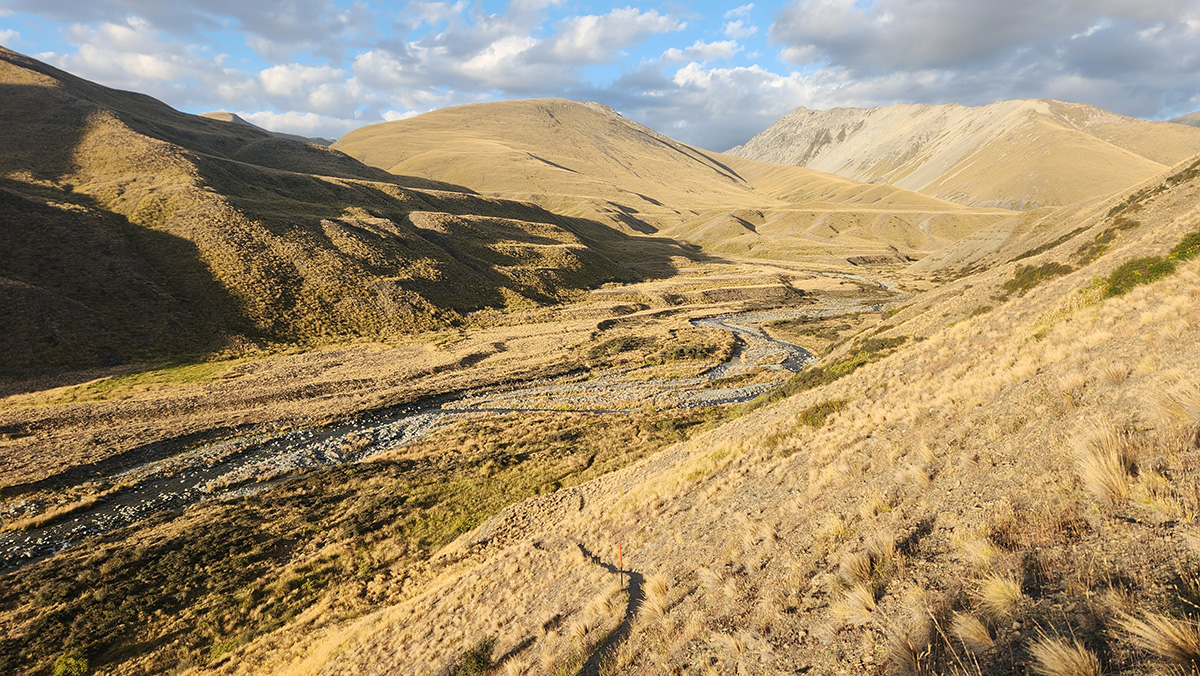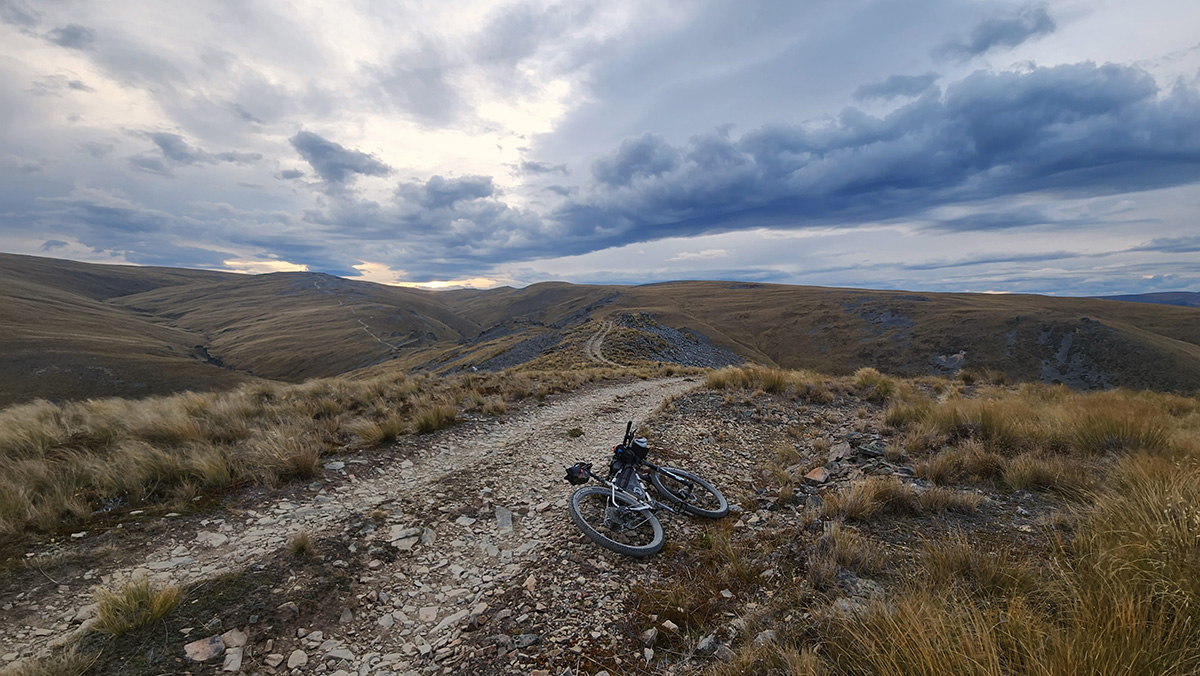Blog
stories • happenings • adventures
Three out of Three: Racing the 2024 Tour Te Waipounamu
On the 28th January the third edition of New Zealand’s hardest bikepacking event, Tour Te Waipounamu (TTW) kicked off at 7am from remote Cape Farewell, the northernmost point of the South Island. Te Waipounamu is the indigenous name for New Zealand’s southern main island; a landform that is defined by the Southern Alps, which shape both the land and the weather patterns of this long island locked in the windy Roaring Forties latitude.
Part bikepacking race, part adventure race, TTW tackles the rugged backcountry and foothills of the Southern Alps head on over its 1330km/826mi length. Pedalling is just one of several skills to have in your quiver for a successful run on this course, because the road, gravel, 4WD track and singletrack sections are separated by challenges that have a particularly Kiwi flavour: unformed, technical hiking trail and two substantial alpine crossings over the Dampier Range and Stag Saddle/Two Thumb Range which both involve significant elevation gain on vague ground trail that requires extensive pushing or carrying.
Photo by Phill Davies
While transalpine hiking ability, upper body strength, micro navigation and general backcountry nous all come into play on sections of this route, robust bike handling skills are also important and TTW is very much a ‘mountain bikers’ bikepacking race. But the rewards for the sometimes ridiculous efforts required to reach the route’s highpoints are long backcountry mountain bike descents that are among the best in the country, both in terms of fun factor and scenery.
With New Zealand’s borders properly open for the first time in this race’s short history (since 2022 TTW is biennial) TTW24 was tipped to be the year of the Trans Tasman battle, with strong Australian riders mixing it up with the Kiwis on their own turf. But it was Kiwis who prevailed with Joe Nation (3rd in Tour Divide 2023) crushing the course record (set by Jakub Sliacan in 2022) in a time of 4d 19h 1m for the mens’ win, while 24 year old Emma Bateup won the womens’ race for the second year running in 5d 23h 59m and bettering her 2022 time by over 11 hours.
My Deep Dive into Bikepacking Racing
It was in mid 2020, during the pandemic, when Brian Alder, creator of TTW first brought the concept of this unique race to my attention. Brian was seeking some feedback on course routing, as well as applications to participate in the inaugural 2021 edition of the race.
The concept captured both mine and Hana’s attention immediately. We’d been in the midst of a multi year bikepacking tour of the American Continents when Covid forced us to abandon South America and bolt for home in New Zealand. Tour Te Waipounamu provided a focus and a goal for the two of us and was a big contributor to keeping our spirits alive after such a big disruption to the life we’d come to know on the road over three plus years.
Prior to TTW the only brevet/race I had done was the infamous Petit Brevet, which tackles over 8000m/26,000ft of elevation gain over 300km/186mi among the gravel and quiet paved roads of Canterbury’s Banks Peninsula. I was high in motivation, but short on racing experience.
Although the touring Hana and I had done overseas had been hard, with all-day Andean climbs, high altitude, massive hike-a-bikes and long back-to-back days, it’s not the same as bikepack racing. Typically, touring takes place at a lower average heart rate, you sleep normal length nights and stops are much more frequent. I had miles in my legs, but not racing miles, and developing that skill would take longer than I imagined.
Prior to the first TTW, the e-book Touring with a Sense of Urgency was a useful resource, as I absorbed every gem of wisdom about race craft. The book spoke to me: the descriptions of 19 hour days and fast turn around sleep stops resonated strongly and I imagined myself doing this in detail. It didn’t sound that hard, it just sounded like you had to be disciplined, be prepared to ‘be the problem solver’ and ‘play the long game’ both of which were concepts that heavily informed my approach to TTW when it finally came around. But it was harder than I thought.
To be honest, there is not much in bikepacking that feels that hard after you have carried 18 days food and fuel over high passes on the sandy ‘roads’ of Northern Argentina’s Ruta de los Seis Miles, or pushed a heavily loaded bike up mule trails at altitude in Peru. Kurt Refsnider’s oft mentioned phrase ‘normalising difficult’ is referred to often in the context of preparation for TTW, but we’d ‘been there, done that’ in the Americas and learned to face difficulties with equanimity.
But the challenges that my first two completions of TTW threw at me were of a different nature: My body letting me down, not my mind. In preparation for the first TTW, my first attempt at ‘racing’ a bikepacking route didn’t begin well. The loosely organised Kahurangi 500 event of late 2020 provided a first opportunity for me to have a crack at very long racing days but on day one I developed pain and swelling in the back of my knee that turned the ride into a battle to finish. Two days later I limped into Murchison barely able to bend my leg to get on the bike.
In the first TTW I experienced distracting achilles tendon pain just halfway through the second day. When I reached Methven two and a half days later I struggled to walk, and spent 36 hours there waiting for the swelling and pain to reduce enough for me to continue (in last place). I finished that year, but it wasn’t pretty. The achilles issue was a problem to be solved and I was determined to finish within the time cut, doing many of the climbs pedalling with my heel.
I spent months rehabbing and strengthening both achilles during 2021 in preparation for the 2022 edition of the race, including having ultrasound guided saline injections into the site of the injury. But only two days into the 2022 race the now familiar pain of crepitus in the tendons was creeping back in. I made it to Methven and bought some plastic flat pedals, which took some getting used to, but allowed me to offload the tendon sufficiently that I could finish the race – and still remain within the top 10. That year gave me an insight into my potential for the race, as I realised I could cope ok with short (3hr or less) sleeps, and I seemed to get stronger in the final days of the event.
In preparation for 2024, I incorporated more core, glute and hip flexor strengthening and I decided to convert to flat pedals for the duration of my training (I’d used them in 2022/23 for five months back in South America too) and although I still experienced some achilles aches, they seemed a much more reliable option for me. Having done much the same training for 2024 as I did for 2022 (Kurt Refsnider’s Ultra MTB 4-month plan), I didn’t expect to be much fitter, but hoped to shave a few hours of my time by refining my efficiency at stops and taking slightly shorter sleeps.
This year I finally got a ‘clean’ race, with the serious achilles issues that plagued me in the past absent. Of course there was some pain, but no more so than I think affects the average competitor in TTW, along with moderately swollen knees, aching in the neck, a sore bum, and sore wrists on some of the rougher descents. Instead of managing a problem for most of the race, I was free to devote my energy to concentrating on riding the best ride I could, using my time well and weathering the typical mental and physical highs and lows that come with ultra endurance sport. Finally I became the racer that I’d visualised back in 2020; riding long and sleeping short with a cooperating body and an unburdened mind.
I finished in 5d, 22hr, 10 min, shaving 16 hours of my 2022 time and coming in 8th place. I’m the only person to have finished all three TTWs, although Steve Halligan had been well on track too until he sadly crashed and broke his femur crossing the Hawkdun Range, while sitting in third place.
Day 1: Cape Farewell to Murchison
268km | 3463m elevation gain | 15:00 elapsed time | 3 hrs sleep
Drafting is permitted for the first 30km of TTW, so the start was fast, but I survived a stray water bottle landing millimetres from my front wheel, while my back wheel went right over it. The first singletrack of the race, the big climb up the Rameka Track, was social with Andy Hovey, Lewis Ciddor and Matt Quirk in close proximity as we settled into the rhythm of the race.
The resupply at Tapawera comes 165km in, and I ate a pie too fast which left me feeling nauseous for the long hot climb up the pylon road, but I was back in the flow on the penultimate climb of the day up the Porika Track, which climbs steeply though beech forest. The rocks and ruts of the gnarly descent went by in daylight this time and I rolled into Murchison over an hour up on my 2022 time and snatched some sleep in a cabin.
Photo by Anton McGeachen
Day 2: Murchison to Dampier Range (965m)
192km | 3219m elevation gain | 19:45 elapsed time | 5 hours sleep
With a 2:20am start from Murchison I passed a few bivvying riders as I followed the Matakitaki Valley and climb to Maruia Saddle in the dark, yoyoing with Richard Dunnett through to Springs Junction where he stopped to wait for the store to open. The biggest sealed climb of the race, Lewis Pass, was beautiful in early morning sunshine and then it was down through the forest and river flats to Boyle Village to collect my resupply parcel.
My bags were heavy and my legs dull as I started the first hike-a-bike challenge of the ride with the Hope Kiwi Track’s technical singletrack, which requires constant dismounts for unrideable sections, gullies and bridges. I know the lines well after five previous trips though here and soon warmed into it, passing a couple of people. I rode with Andy Hovey over much of the second half through to Lake Sumner and onto Lake Mason. By the time we reached the base of the huge hike-a-bike over the Dampier Range a group of four including Matt Dewes and Adam Rozsa had coalesced and we pushed and carried up the steep initial slopes before stopping to bivvy in the tussock shortly after dark, at the civilised hour of 10:00pm. That way we could sleep, do the remainder of the climb in the dark in the morning, and have daylight for the hard, high sidle and the descent. By now I was eight hours up on my 2022 time.
Day 3: Dampier Range to Peel Forest
246km | 3423m elevation gain | 23:00 elapsed time | 3.25 hours sleep
I was away shortly after 3:30am, in pursuit of a lanky figure who’d passed our camp shortly after 3:15. I felt good after what would be by far my longest sleep of the ride, and made good time up the vaguely tracked ridge and sidle, spurred on to catch who I’d taken to be race organiser and friend Brian Alder. At the summit Brian turned out to be single speeder Pete Marriott, who turned out to be good company anyway, as we used the power of two sets of eyes to nail the line through the waist deep tussock traverse and out to the descending ridge – one of the best all-mountain downhills of TTW.
After a rowdy morning my legs fell off somewhere along the 4WD and gravel roads of the Esk and Waimakariri Valleys and it took another six hours to find both them and my appetite. By that time I was spat out the other end of the Craigieburn singletracks having walked most of the climbs.
Photos by Anton McGeachen
Past Lake Lyndon Pete Marriott caught me and we paced each other side by side as we rode headlong into a vigorous easterly on the way out to Methven. Unexpectedly the Four Square had stayed open, so I picked up bonus supplies and pushed on across the Canterbury Plains with Matt Dewes often close by. The eaves of the kitchen/toilet block at Peel Forest made a suitable bivvy spot, and the mysteriously dead birds nearby hadn’t fazed Emma Bateup either, who was already asleep on the concrete.
Day 4: Peel Forest to Lake Pukaki
161km | 3340m elevation gain | 19:45 elapsed time | 3.5 hours sleep
In the early morning the Rangitata Valley was windless and I made good time up to the start of Mespotamia Station and the ‘Queen Stage’ of TTW, with its three big back to back climbs and the route’s high point over Stag Saddle. I caught Emma B on the first climb over to Felt Hut and it was good to have a temporary companion for this stunning high country ride and long trudge up Bullock Bow Saddle. Emma fell back on the descent with dropper post trouble and then a gazelle carrying a singlespeed (Phill Davies) caught me on the hike-a-bike to Stag Saddle. We caught up to Matt Dewes and Slo-Mo whose lead I’d been I’d been nibbling at for hours, but my speed was no match for Phill’s as he rocketed on ahead over the stark, rocky saddle.
Snake Ridge carried me down into the fairytale, mountain ringed landscape that is the Mackenzie Basin on a fine day. But Tekapo’s further away than it looks and first one must duel with a corridor of matagouri thorns, chunky riverbed and a final goat track HAB to reach singletrack sanctuary. There is no food to be found in Tekapo after hours, so I headed for the next most useful facility: the toilets, where I found Phill also pit stopping for a moment. Canal roads and grassy undulations drifted by in darkness and I reached the shore of Lake Pukaki at 3am. I crawled under a fir tree to escape the rain and catch some sleep, 13 hours up on 2022.
Day 5: Lake Pukaki to Oliver Burn Hut
223km | 4273m elevation gain | 22:00 elapsed time | 90 minutes sleep + one 10 minute nap
Even the 14km of brutal babyhead river stones of the Pukaki River Road would not diminish my spirit this morning, with the steady climbs and fast descents of Black River Station and the Otematata resupply in my sights. At the top of the first long climb, everything seemed so perfect that my emotions exceeded threshold and I flew down the descent in a flood of tears. At Otematata, Emma was sitting on the footpath indulging in the bounty of the On the Spot store, while Lewis (who would move into third over the next 24 hours) came and went in a blaze of energy.
Bags loaded with food I left and 8.5 hours later I was in Oturehua, with the 2200m of climbing over the 4WD tracks of the Hawkdun Range behind me. Midnight and the Ida Valley sped by and then in the wee hours I climbed towards the final big obstacle of the race – Rough Ridge and the Lammerlaws. With one slowly failing light left I reached the shelter of the tiny Oliver Burn Hut at 5am and lay down for a 90 minute sleep, broken with Phill also arriving for a nap.
Day 6: Oliver Burn Hut to Slope Point
248km | 2750m elevation gain | 22:10 elapsed time | one ten minute nap
It was daylight when I left Oliver Burn and threatening weather filled the horizon as I passed Lake Onslow, riding hard to catch Phill and put time into Emma, Myles and Pete. The exposed, treeless landscape of the Lammerlaws is no place to be in bad weather, but I pushed on in full waterproofs as the front kicked in and cold rain and wind buffeted the range. Sheep shit splattered muddy tracks and bogs slowed progress as I surged up the climbs to keep warm for the descent. But it took over 30 min to stop shivering in Lawrence as I downed hot drinks in a daze and fell asleep at the table. Snapping out of it I rode the undulating, tedious country roads to Clinton and was saved by a half a pizza and a 10 minute nap in the hotel.
The dogs would be nipping at my heels if I didn’t get some pace on, and I rode the first half of the final 92km quickly until the sleep monster tried to swallow me whole. A squirt of water to the face washed away the hallucinations and dream state that flowed in and out of my consciousness as I weaved around on the road. Distant lights that could have been a pursuer raised my adrenaline and I shifted into time trial mode for the next 40km. Cruising up the final short climb before the finish I tried to allow it all to sink in, but I was an emotionless zombie. My primate brain had taken full control: all I knew was to keep moving forward. Don’t think, just ride.
And then there I was, standing in the dark, beside a lonely signpost on a windswept cliff edge above the Southern Ocean.
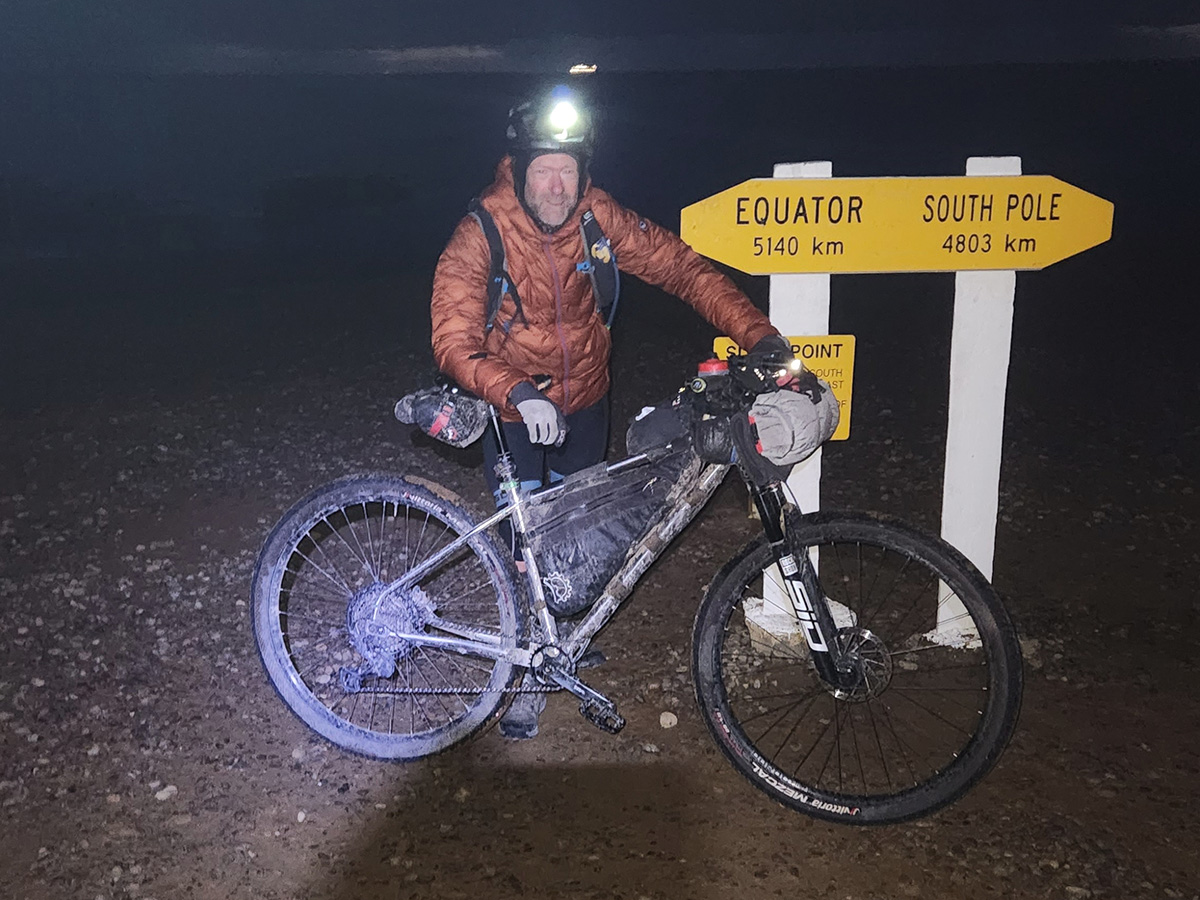
Photo by Brian Alder
Mark’s Bag Setup
Mag-Tank
Mountain Feedbag x2
Pronghorn Handlebar System
Shrew Seat Bag
Ranger Frame Bag
Check out Mark’s unpacking video here:

